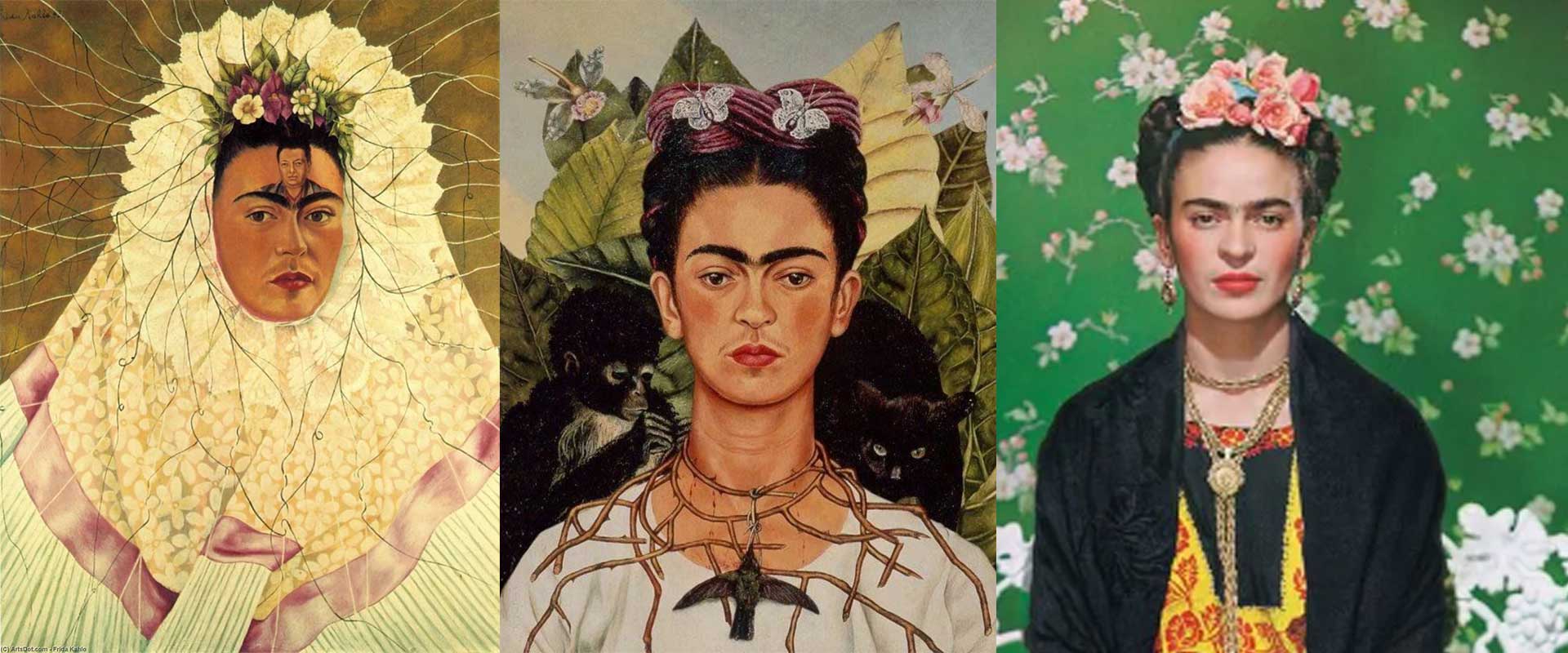Few artists in history have turned the act of self-portraiture into a medium of emotional truth quite like Frida Kahlo. Her self-portraits are not just images of a woman—they are windows into her soul, filled with symbolism, suffering, and unflinching honesty. But what is it about these paintings that has captivated the world for nearly a century?
Let’s explore the emotional depth, cultural richness, and symbolic complexity that make Frida Kahlo’s self-portraits so powerful—and so timeless.
They Speak the Language of Pain and Strength
Frida’s life was filled with unimaginable physical and emotional pain. After a devastating bus accident at age 18, she endured chronic pain, multiple surgeries, and infertility. Instead of hiding it, she embraced it on canvas.
In works like The Broken Column, she painted herself with a shattered spine, bound by a surgical brace, her face stoic but streaked with tears. In Self-Portrait with Thorn Necklace and Hummingbird, blood drips from her neck, yet she stares directly at the viewer—calm, composed, unwavering.
These portraits confront pain without melodrama. They reflect strength through vulnerability. In today’s world, where conversations around trauma and healing are finally surfacing, Kahlo’s emotional transparency still hits a nerve.
A Table of Symbolic Depth in Key Self-Portraits
| Self-Portrait | Year | Core Message | Symbols | Mood |
|---|---|---|---|---|
| The Broken Column | 1944 | Pain and resilience | Nails, brace, cracked torso | Stoic suffering |
| Self-Portrait with Thorn Necklace | 1940 | Martyrdom and sacrifice | Thorns, monkey, cat, hummingbird | Meditative, painful |
| The Two Fridas | 1939 | Inner conflict and duality | Hearts, scissors, artery | Isolated, reflective |
| Self-Portrait with Cropped Hair | 1940 | Gender identity and rebellion | Men’s suit, cut hair, scissors | Defiant, liberated |
| Self-Portrait Dedicated to Dr. Eloesser | 1940 | Gratitude and recovery | Heart, medical references | Gentle, spiritual |
Each self-portrait becomes a chapter in her visual diary. They don’t just show what she looked like—they reveal what she endured, questioned, and celebrated.
They Break Beauty Norms—and Redefine Them
In an era obsessed with perfection, Frida Kahlo dared to be unapologetically herself. Her unibrow and faint mustache weren’t hidden—they were highlighted. She often painted herself wearing traditional Tehuana clothing, signaling pride in her Mexican and Indigenous heritage.
By rejecting European standards of beauty and femininity, Frida’s portraits assert: “I define myself—no one else.”
Today, as body positivity and self-acceptance movements flourish, her message feels especially empowering. Her self-portraits still tell us that real beauty lies in authenticity.
They Merge the Personal and the Political
Kahlo was a passionate political thinker. Her self-portraits—while personal—are often laced with commentary on colonialism, gender, fertility, and cultural identity. She used her image as a canvas for resistance.
By placing herself at the center of symbolic storms—whether filled with animals, natural disasters, or broken hearts—Frida makes a bold statement: the personal is political.
This makes her art resonate not just as autobiography, but as a universal symbol of protest, resilience, and pride.
They Champion Feminist Expression
Long before the feminist art movement emerged, Kahlo painted subjects that were taboo: childbirth, miscarriage, bodily injury, mental illness, and betrayal. She turned her own body into a battleground and a symbol.
Her portraits portray the female experience with unflinching honesty. There’s no male gaze—only her own. That gives her work a liberating power that speaks to women and marginalized voices around the world.
They Invite Introspection
Frida Kahlo’s self-portraits make us reflect—not just on her life, but on our own. Viewers are often pulled into the intensity of her gaze. Her portraits don’t ask for pity. They challenge you to look at your pain, identity, and history with the same courage.
They are both mirrors and maps—offering us a chance to see ourselves more clearly through her experience.
Their Influence Is Global and Eternal
Frida Kahlo is now a worldwide icon. Her face, her flowers, her gaze—these are etched into pop culture. Yet her influence isn’t shallow; it’s spiritually and emotionally profound.
Her legacy lives on in:
- Feminist art and literature
- Latina and Indigenous representation in media
- Mental health awareness movements
- Gender and identity politics
You can explore this enduring impact through our curated Frida Kahlo wall art prints or browse more timeless works in our full artist collection.
Conclusion
Frida Kahlo’s self-portraits are powerful because they are honest, unfiltered, and revolutionary. They show us what it means to turn suffering into strength, identity into art, and truth into legacy. Her paintings are not just historical records — they are eternal emotional documents.
Every generation finds something new in Frida’s face — whether it’s courage, pain, empowerment, or clarity. That’s why her self-portraits will always speak, challenge, and heal — long after the paint has dried.





